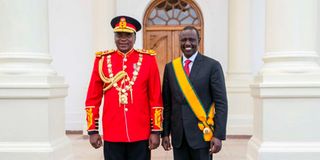Uhuru, Ruto impoverish more Kenyans - report

President Uhuru Kenyatta and Deputy President William Ruto. The number of households suffering low access to basic services has almost doubled in the past nine years when the two leaders have been in charge of government.
Close to two-thirds of households in Kenya are exposed to poverty, leaving them without access to basic public services such as healthcare and education, a newly published index that covers factors beyond income shows.
The study conducted by researchers at the State-run Kenya Institute of Public Policy Research and Analysis (Kippra) shows that 63 per cent of Kenyan households experienced “multidimensional poverty” in the financial year 2020/2021. The measure takes into account income as well as access to safe water, sanitation, education, electricity, food and housing, among other indicators.
This is 10 percentage points higher than the 53 per cent recorded by the Kenya National Bureau of Statistics (KNBS) in 2018 and 25 percentage points higher than the levels registered in 2014.
This means that the number of households suffering low access to basic services has almost doubled in the past nine years.
Low education levels
A household is considered multidimensionally poor if it is deprived in three or more of the indicators. For instance, low education levels, inadequate housing, and low economic activity are often the largest contributors to poverty, making multidimensional poverty levels high.
Researchers at Kippra said that 80 per cent of households in 15 counties have no access to basic services, and urged administrators in the devolved units to intervene and provide social welfare programmes.
“A high percentage of households are deprived of essential goods and services and this, coupled with the low absorption of the budget allocated to social welfare programmes, is lagging efforts to address poverty.
“Counties can also enhance existing programmes that directly and indirectly reduce levels of poverty such as agricultural projects and educational scholarship, among others,” the report stated.
The Kippra study notes that 40 per cent of populations in 42 of the 47 counties were living in multidimensional poverty.
Wajir most affected
The latest World Bank figures show that Kenya had a population of 53.7 million by 2020, while KNBS reported that the country had 47.5 million people, in the 2019 census.
According to the Kippra study, Wajir residents are the most affected, with 94 per cent of households living in poverty. Mandera County follows closely with 92 per cent of its residents poor. Turkana completes the list of the worst three counties with 91 per cent. Marsabit, West Pokot, Bomet, Busia, Kitui, Samburu, Siaya, and Migori counties have between 80 and 88 per cent of their residents living in multidimensional poverty.
Over half of the households in 36 counties are stuck in multidimensional poverty, the report reveals.
In terms of food poverty, Busia, Mandera, Marsabit, Samburu, Tana River, Turkana and West Pokot have over half of their populations unable to access food, the report shows.
Going by the 2019 census figures, 15 of the poorest counties with a combined population of 13.6 million have 11.3 million of their residents living in poverty, meaning that only 16.8 per cent of residents in the counties have escaped the poverty trap.
At least 16 counties have 40 per cent of their populations lacking food, while in 31 counties, over a third of their populations are starving.
Social protection
Kippra recommends that counties should supplement national government social protection initiatives, by developing county-specific cash transfer programmes to prevent more households from sliding into abject poverty.
“County governments to identify and address causes of low absorption of social welfare budgets and have in place mechanisms to map out the vulnerable members of the society, promote programmes that directly and indirectly reduce food poverty such as kitchen garden initiatives, nutrition programmes and other empowerment programmes,” the institute recommends.
The institute further advises counties to partner with the private sector and development partners to initiate programmes that build skills in self-employment and employability among the youths and women to enhance labour participation as a way to fight poverty.
The report sheds light on the extent of suffering Kenyans continue to go through as high prices of food and other basic commodities become the order of the day.





